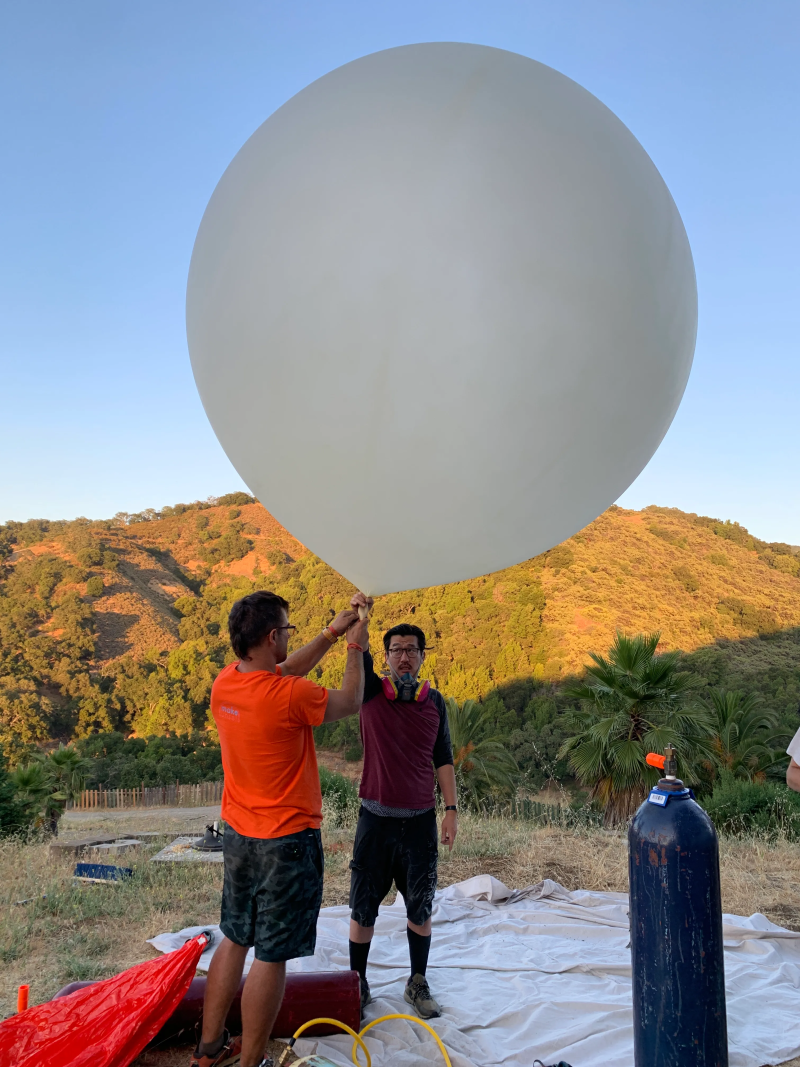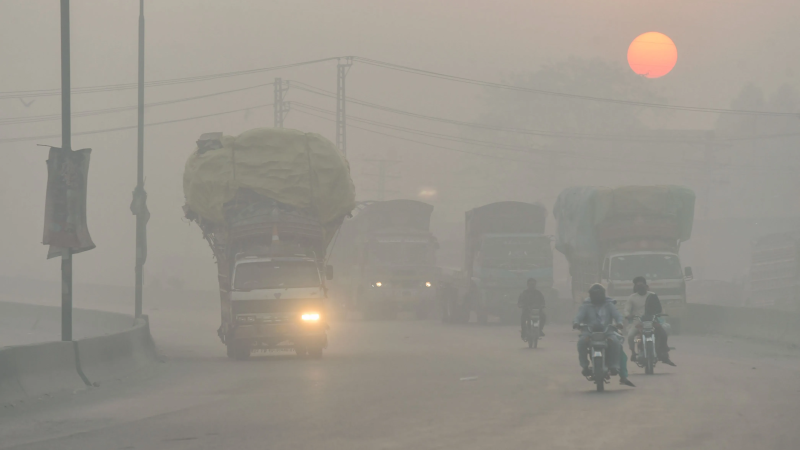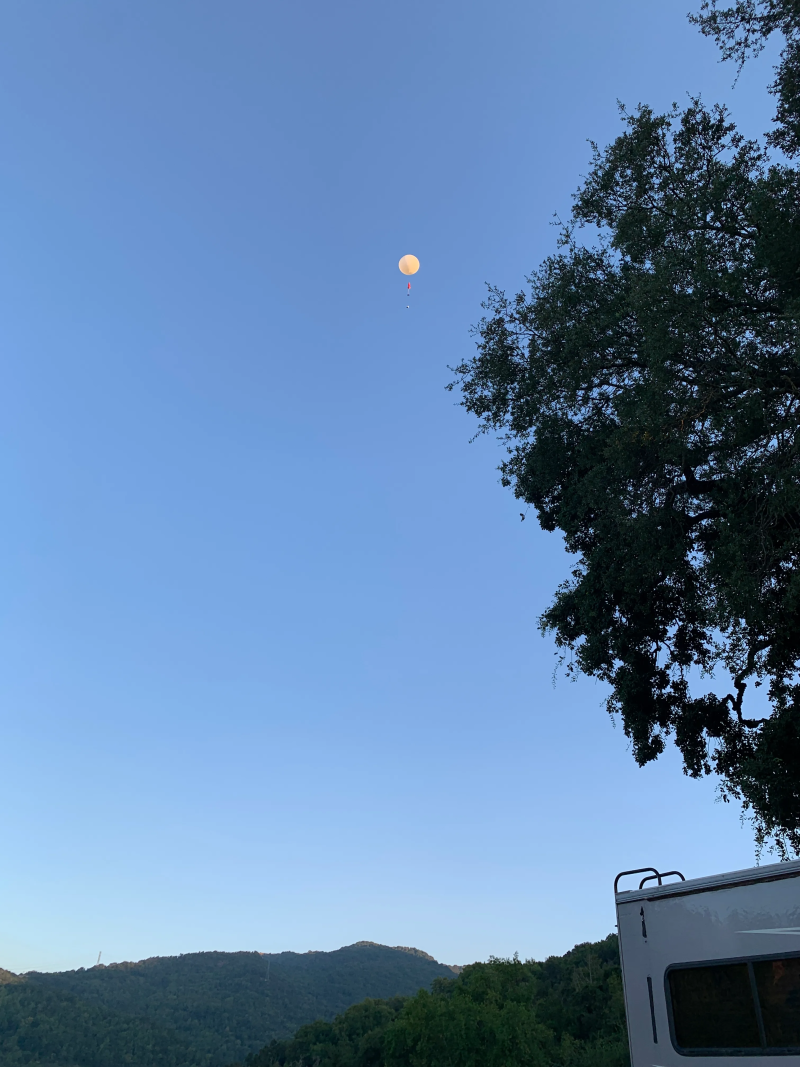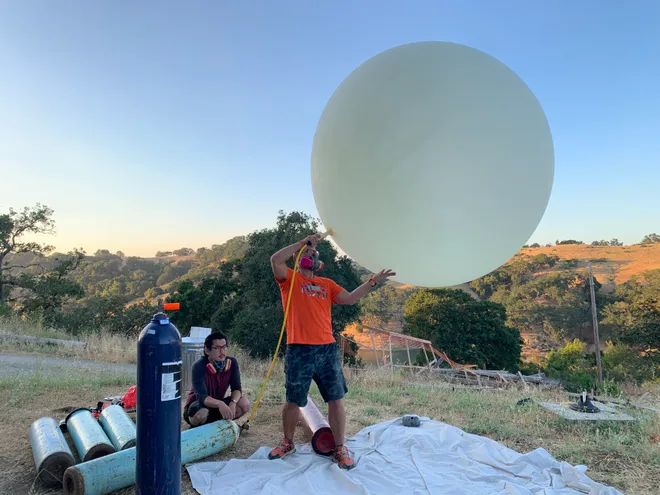This climate change fix could save the world — or doom it
SANTA CLARA COUNTY, Ca. – Luke Iseman and Andrew Song weren’t doing anything illegal hauling around 200-pound cylinders of sulfur dioxide in Song’s RV to pump into weather balloons.
Against the law, no. Controversial? Absolutely.
On a golden California summer evening at the rural edge of Silicon Valley, Song pumped 3.8 pounds of the gas into the balloon while Iseman readied a small Styrofoam box holding an altimeter and locator module.
Next, Iseman attached the balloon's neck to a cylinder of helium. It slowly filled and rose until it became a giant floating orb taller than he was.
With a gentle push, he sent the biodegradable latex globe lofting into the air. It rose past a giant oak tree and drifted into the clear evening sky.

At just over 14 miles up, well above the air space of commercial planes, the balloon popped, sending its tiny payload of invisible yet reflective gas into the stratosphere.
“Our goal,” said Iseman, a serial entrepreneur, “is to cool the Earth.”
Graphics:Humans warmed Earth. Can't we just cool it? Here are some ideas.
These two men, both veterans of storied tech incubator Y Combinator and with stints at multiple tech companies under their belts, sit at the bleeding edge of a global effort to protect the planet from climate change. Their company is called Make Sunsets.
At an infinitesimal scale, they are doing what giant volcanos have done since Earth’s infancy – launching a slightly reflective gas high into the stratosphere where it deflects a tiny portion of the sun’s energy – which incidentally also causes more colorful sunsets.
When Indonesia’s Mount Tambora erupted in 1815, scientists say the huge amount of spewed dust and sulfur dioxide cooled the global temperature that year by as much as 2 degrees.
But what Iseman and Song say are baby steps toward saving the planet, longtime climate scientists fear is the opening of a Pandora’s Box, leading to what could be a domino effect of catastrophic consequences.
“I agree this isn’t the best way to do this – it should be an international coalition of countries and NGOs and led by brilliant scientists,” said Iseman.
Unfortunately, he doesn’t see that happening any time soon, he says with some heat.
“Way too many smart people are spending way too much time going on about politics and downsides and how some other thing would be ideal while the world literally burns.”
He’s content knowing the night’s payload was enough to offset 1,745 tons of carbon dioxide for a year, about 380 cars' worth.
'It’s morphine’
For years, experts considered climate engineering, also known as geoengineering, a dangerous science fiction.
Confronted with ideas like fertilizing the world's seas to produce enormous algae blooms that would sink to the ocean floor, adding millions of tons of sulfur dioxide to the stratosphere each year or launching huge sprays of salt water into the air over oceans to make low-lying clouds whiter and longer lasting, they collectively threw up their hands in horror.
The Center for International Environmental Law calls geoengineering “dystopian technologies.” Hands off Mother Earth has a manifesto signed by more than 100 organizations in 45 countries calling for a ban on all geoengineering field experiments. The ETC Group, an international activist group, monitors geoengineering attempts.
But something has changed in recent years: Some environmental groups are begrudgingly acknowledging that humans will almost certainly have to use some methods to try to cool Earth while carbon dioxide levels are lowered and that these could end up being part of a global coping mechanism for climate change.

“Environmental groups are realizing if they don’t engage in the topic, it’s not going to stop the conversation and research from happening, so they better engage or they won’t have any say at all,” said Katharine Ricke, a professor of climate science and global policy and strategy at the University of California, San Diego.
Figuring out geoengineering needs to happen quickly because the decision point is probably coming sooner rather than later, said Wake Smith, a lecturer at the Yale School of the Environment whose most recent book is “Pandora's Toolbox, the Hopes and Hazards of Climate Intervention.”
“I'm afraid the climate problem is worse than you think it is,” he said. Geoengineering, especially the solar geoengineering that Make Sunsets does, isn’t a solution but could buy time for the world to rapidly cut back on carbon emissions. “It isn’t penicillin, it doesn’t cure the disease,” he said. “It’s morphine, it helps while you’re healing.”
Scientists aren't yet sure what's the best metaphor for geoengineering ‒ is it medicinal morphine to give the Earth time to heal? Or is it illicit opioids that could cause the planet further harm?
Given that uncertainty, many international groups still think it's far too dangerous to even experiment with.
And yet, despite those fears, Make Sunsets keeps launching its balloons.

What could go wrong?
Conservationists fear geoengineering could cool the Earth too much or unevenly. It could damage ecosystems, disrupt global weather patterns or potentially make global warming dramatically worse if a geoengineering project were to suddenly stop.
It could lead to drought, famines and even wars if such efforts caused shifts in the monsoon rainfall patterns that much of Asia and Africa depend on for farming. Or it could supercharge storms. Or it could potentially allow one country to steal rainfall from another.
In one nightmare scenario, dubbed “termination shock” by scientists, solar geoengineering efforts are deployed at a large scale globally and then suddenly stopped due to political in-fighting. That would lead to a possible rebound effect.
Without artificial cooling, the Earth might rapidly and chaotically warm, causing havoc far worse than slow warming. In another scenario, geoengineering cools one area of the globe more than another, furthering global inequity.
But no one knows if any of these will come to pass, which is why many scientists and an increasing number of conservationists think at least researching the various methods is important.
And always in the back of everyone’s mind is the "moral hazard" fear that if stopgap measures are deployed that mask the results of skyrocketing carbon dioxide levels, the public may think it's now OK to keep burning coal, oil and natural gas – meaning the underlying cause of the problem only gets worse.

A startup does what was once unthinkable
Geoengineering technically comes in two flavors, one more controversial than the other.
The first is underway already: efforts to rid the Earth's atmosphere of the excess carbon dioxide humanity has been pumping into it since the Industrial Revolution.
The second is more hypothetical – the ones that some fear could backfire spectacularly.
This category of geoengineering involves trying to find other ways to artificially cool Earth, to offset the damage done by greenhouse gasses while fossil fuel burning is ended and greenhouse gas levels slowly fall.
Make Sunsets' work falls in the second arena.
Some fear if Make Sunsets' type of solar geoengineering were ever done at scale, it could cause the Earth to rebound to even higher temperatures if the sulfur dioxide treatments were stopped.
It's not so controversial to Iseman. He notes humans already pump tons of sulfur dioxide into the atmosphere from burning fossil fuels every year. But that's in the lower atmosphere, where it can harm lungs but does nothing to reflect the sun's rays.
Make Sunsets aims higher, into the stratosphere, where the gas will linger about a year before falling back to Earth.
They are careful to alert the Federal Aviation Administration before each launch via a Notice to Airmen, as well as logging each balloon launch with the National Oceanic and Atmospheric Administration.
By dark, the co-founders of the tiny startup have launched two more balloons at the behest of some of their 600 or so customers, each of whom pays to be part of what they see as not a solution but a stopgap.
“Someday, hopefully, this will lower the temperature slightly to buy us time while we stop burning fossil fuels,” said Iseman.
Money changes the game
A new development has forced some experts to change their position on geoengineering: For-profit companies, like Make Sunsets, are entering the mix of what had been an entirely university-researcher-driven enterprise.
Questions of regulation and accountability remain unanswered. And so, many scientists say they want to be part of what is inevitably happening, rather than wishing it wouldn't.
“The movement in the startup space is really scary, honestly. The prospect of for-profit actors is alarming,” said Ricke. “You have people lobbying for the deployment of technology not because it’s necessarily good for the planet but because that’s how investors make back their money.”
The arrival of at least two companies looking to make money off geoengineering has heightened fears. Small-scale Make Sunsets has about 600 customers buying its "cooling credits," which pay for its launches.
But an America-Israeli startup called Stardust Solutions has also entered the scene. With $15 million in funding, it only recently became public about its ambition to create a solar geoengineering solution it could sell to governments or international entities.
As climate catastrophes continue, “people’s perceptions of how the climate is changing the urgency of the situation is mounting,” said Daniele Visioni, a professor of earth and atmospheric sciences at Cornell University who’s studied climate intervention for the past decade.
The Sierra Club remains highly skeptical but acknowledges that “it might be good to start to study some of these things,” said Patrick Drupp, director of climate policy and advocacy.
The Natural Resources Defense Council doesn’t support deployment of solar radiation mitigation and wants to see international rules of the road for any tests, but does support “limited” outdoor experiments that have been subject to independent review.
Who decides what can be done is a looming question, said Visioni.
“The stratosphere is a very unregulated piece of real estate," he said. "How do you stop a private actor from just launching a balloon?"
So far, the answer appears to be that you can’t.
Disclaimer: The copyright of this article belongs to the original author. Reposting this article is solely for the purpose of information dissemination and does not constitute any investment advice. If there is any infringement, please contact us immediately. We will make corrections or deletions as necessary. Thank you.






